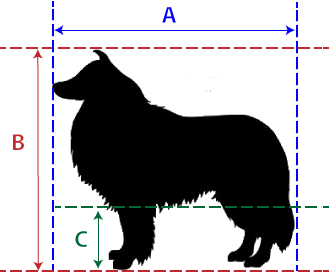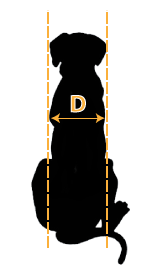International and Domestic Travel with Pets - Guidelines and advice
Things You Need to Know Before Undertaking
International and Domestic Travel with Pets
Some airlines will not accept certain breeds of dog or cat, and some airlines do not accept pets for carriage at all, therefore your pet may need to travel with a different airline. For domestic travel within Australia, Jetstar and Tiger do not accept pets for carriage. This limits your choice to Virgin and Qantas.


|
Carrier
|
Internal dimensions (cm)
Length x Width x Height
|
Suitable Breeds
|
Max Weight
|
|
PP20
|
49L x 32W x 36H
|
Cats, small puppies, rabbit, guinea pig
|
10kg
|
|
PP30
|
60L x 39W x 45H
|
Bichon, Jack Russell, Peckinese
|
15kg
|
|
PP40
|
69L x 39W x 51H
|
Cocker Spaniel, Cairn Terrier, West Highland Terrier
|
20kg
|
|
PP50
|
77L x 52W x 60H
|
Beagle, Whippet, Staffy, Small Border Collie
|
25kg
|
|
PP60
|
88L x 57W x 74H
|
Golden Retriever, Labrador, Siberian Husky, Australian Shepherd
|
35kg
|
|
PP70
|
110L x 60W x 78H
|
Afghan, Doberman, Airedale, Setter, German Shepherd, Rottweiler
|
50kg
|
It is not recommend that your pet be sedated. If your pet is familiarised with the carrier/crate well in advance of their flight (see point 5) sedation is unnecessary. However if you do feel that this is necessary, you should seek veterinary advice on appropriate medication and dosage. Ensure you notify the airline when checking in that your pet has been sedated. You will need to supply the name of the drug, administration time and dosage level.
The most common sedative used is Acepromazine (ACP). ACP has been found to have the following consequences for travelling pets:
- It relaxes the respiratory muscles making breathing difficult. This leads to over-exertion just for breathing, which lowers blood sugar and can also alter the body's temperature control mechanism.
- Animals administered this drug often lose their righting ability, their sense of balance and ability to maintain equilibrium.
- Depending upon the dosage, they can lose the ability to correctly position themselves within the carrier/crate and are susceptible to injury as well as obstruction of their airway due to an abnormal posture. This can also be dangerous as your pet will most likely will be exposed to increased altitude pressures, heightening the risk of respiratory and cardiovascular problems while travelling.
Airlines have specific procedures in place for the acceptance, handling and delivery of animals. The environmental needs of the animals are duly considered during loading, off-loading or at a transit stop.
You can either find an animal shipper who can make all the necessary reservations and take full charge from collecting your pet, boarding it if need be, taking it to the airport and having it met at the other end and delivered to it's final destination.
In some countries, this may be the easiest and surest method and some airlines will not accept animals handled by anyone other than a animal shipper. The airlines can usually give you a list of preferred shippers with whom they work.
It is possible however for you to make all the transport arrangements yourself. If you plan to do this check with the airline well in advance to ascertain their rules and any special requirements they may have for shipping pets.
Health Certificate
Most airlines require a health certificate for any animal they are transporting, whether it be in the cabin or as an unaccompanied shipment. The health certificate is prepared by your veterinarian and should stipulate that your pet animal is healthy and fit to fly.
Flight confirmation
Contact the airline you have selected to confirm that they will accept your pet on the day and flight that you prefer. Some airlines restrict the number of animals on a flight so the more advance notice you give them the better. Reconfirm at least 48 hours before departure.
Check-in
Find out how soon before the flight you have to check in. Pets become stressed with all the bustle at an airport, so keep it to a minimum.
- If your pet is allowed in the cabin, check in as late as possible.
- If it is going in the hold, check in early so that it can go to the baggage area and be put somewhere quiet and dimly lit in order to relax.
By following these guidelines and planning your pet's flight well in advance you will minimise stress on both yourself and your pet. This will give you time to plan and cope with any issues that arise well before the departure date.
Search by Category
Cat Food
Categories
- Worm & Flea Control for DOGS
- Worm & Flea Control for CATS
- More DOG Products
- Snacks & Treats
- Feeding Bowls & Utensils
- Dog Toys For Healthy Teeth & Gums
- Kennels & Bedding
- Collars, Chains, Leads, Halters & Harnesses
- Shampoos & Conditioners
- Grooming Equipment
- Dog Coats
- Pet Carriers, Crates & Pens
- Waste Disposal/Worm Farms
- Lawn Burn Treatments
- Dog Food
- More CAT Products
Search by Manufacturer
- Manufacturers
- Absorbent Products
- Catmate
- Advance for Cats
- Advance for Dogs
- Aristopet
- Bayer
- Biolac
- Black Dog
- Black Hawk Pet Care
- Bono Fido
- Box 1
- Canidae Holistic
- Coolaroo
- Coprice
- Dermcare
- Dog Gone Smart
- Dog Rocks
- Doggyman
- Double K Industries
- Eagle Pack
- Eukanuba
- Felidae Holistic
- Fibrecycle
- Fido's
- Fort Dodge
- Greenies
- Hagen
- Heaven Scent
- Herm Sprenger
- Hills Science Diet
- Iams
- Interpath
- K9 Homes
- Kazoo
- Kong
- KraMar
- Lawrence
- Melrose Omegapet
- Merial
- Micio Mao
- Mitavite
- Nature Vet
- Novartis
- Noztonoz
- Nutrience
- Nutro
- Pedigreee Dentastix
- Pet Loo
- Petmate
- Pfizer Animal Health
- Plush Puppy
- Purina Fancy Feast
- Purina Pet Life
- Purina Pro Plan
- Reln
- Royal Canin
- Snooza
- Solvit
- T&S Pet Products
- Virbac
- Weatherbeeta
- Yu Shampoo & Conditioners




